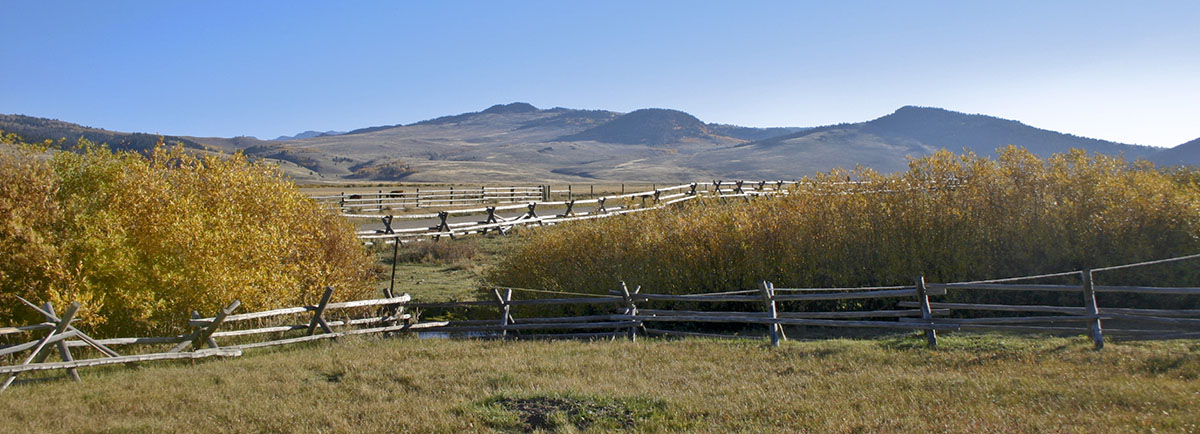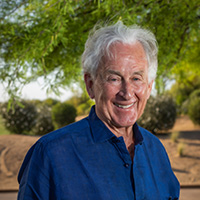Overview
Executive Summary
Corral Creek Ranch consists of 400± deeded acres in the Alaska Basin of the renowned Centennial Valley. The Alaska Basin is the eastern extremity of the Centennial Valley at the furthest headwaters of the Missouri River. The Basin is shared with three other small holdings, all of which are protected from development by conservation easements or deed restrictions. The ranch includes private, BLM and U.S. Forest Service leases of more than 5,000 acres which provide summer grazing for a small cattle operation. It is crossed by Corral Creek and contains three stocked fishing ponds, irrigated hay meadows, open rangeland and timbered hillsides. Improvements include an exceptionally attractive two-bedroom house and guest cabin designed by Jonathan Foote. A separate compound includes employee housing, barns and sheds situated along the gravel county road about 30 miles west of West Yellowstone. The ranch enjoys a beautiful setting under the high peaks of the Centennial Range and will benefit enormously when the National Wildlife Refuge, now just two miles away, completes its planned acquisition of a major portion of the Basin adjacent to the ranch.
General Description
Corral Creek Ranch is best described approaching it from the west. The main public road that serves the valley curves around the end of a high ridge that protrudes into the valley and demarcates the beginning of Alaska Basin. The valley lays out pretty much east and west but the road comes around the corner and for a short distance is headed almost due south before turning east again. As one looks south, the ranch boundaries begin almost immediately on both sides of the road and the entire ranch is laid out in front, framed under the high peaks of the Centennial Range. The foreground is the ranch meadows, then the eye moves to the classic barn and log buildings in the middle ground. Behind this compound there is an expanse of open sagebrush range which leads up to the tree line where the owner’s home and guest cabin are tucked in against the forest. Towering above are the mountains that form the continental divide and the border with Idaho. This is truly an impressive panorama and a great introduction to Corral Creek Ranch.The main features of the ranch are its irrigated meadows on the valley floor which give way to sage brush rangeland that lies along the edge of the valley. As elevations increase the rangeland in turn gives way to timbered foothills. The deeded 400 acres lie at the lower/western end of the ranch and are adjoined as one moves to the east by the Demetriades private grazing leases and then one reaches the head of the valley where the 5,000 acre U.S. Forest Service permit is located. The south side of the ranch rises rather abruptly into the timbered BLM lands which the cattle use sporadically in conjunction with the deeded and leased grazing lands. The ranch has a small BLM permit in this area. The owner’s home and the one-bedroom guest house are located on the southern border of the ranch and are nestled into the timber. The operating improvements sit on the main road for ease of access in inclement weather. Corral Creek flows out of the mountains across the ranch’s deeded lands before becoming part of the Red Rock River just below the ranch. Besides providing water for irrigation, Corral Creek and Hell Roaring Creek have been diverted to serve three trout ponds where the fishing is reported to be excellent. One of these ponds is just below the main house and offers a wonderful foreground for views from the sun porch across the valley.
Broker's Comments
Corral Creek Ranch is a unique and private small operating ranch – essentially an inholding – at the head of the heavily protected Centennial Valley next to the Red Rock Lakes National Wildlife Refuge. Improvements include an early Jonathan Foote house and guest house. A beautiful and remote setting in a coveted location with surprisingly easy access in season to Henry’s Lake, the Madison River, and Yellowstone Park.
Locale
Location
Corral Creek Ranch is situated in the Alaska Basin in the uppermost reaches of Montana’s expansive Centennial Valley about 30 miles west of West Yellowstone and 13 miles east of Lakeview. Its location is about 10 miles west of Henry’s Lake. The nearest commercial air service is the seasonal airport at West Yellowstone. There is extensive year-round commercial air service at Bozeman – about 115 miles to the north. The easiest access to the ranch is from the east taking U.S. Highway 287 south from Ennis turning onto U.S. Highway 87 to Henry’s Lake where one turns west and follows the paved road along the lake. It becomes graveled as one leaves the lake for the last 10 miles to the ranch. This road is closed to vehicular traffic during the winter. The ranch is accessible only by snowmobile during the winter months on a packed snowmobile trail.
Locale
The Alaska Basin is the furthest headwaters of the Missouri River and is tucked up under the continental divide. Its multiple creeks including Corral Creek (formerly Horse Camp Creek) come together in the basin to form the Red Rock River which eventually becomes the Beaverhead River just above Dillon. There are essentially three ranches in the basin – soon to be reduced to two. Corral Creek on the south side of the basin includes the land and leases described herein and there is the Huntsman Ranch on the north side of the basin. The ranch in the middle of the basin was formerly a grazing association and has been sold to a somewhat mysterious conservation group that is reportedly in the process of reselling it to the National Wildlife Refuge. We are told that the first portion of this transaction is scheduled to close by the end of 2010. When this ranch is entirely in the hands of the Refuge, it will result in Corral Creek Ranch being virtually surrounded by public land. It does have one neighbor to the west – essentially over a high ridge that is summer grazing for a large operating ranch based 50 miles north in the Madison Valley. There are two small parcels to the east that are leased to Corral Creek for grazing and they are protected from development by a conservation easement, as is the Huntsman Ranch. In short, Corral Creek Ranch lies in an area where it is one of the very few private inholdings in a vast landscape of federal and state lands. The Nature Conservancy has targeted this region as one of special interest for protection. They have been very successful in working with local ranchers and the federal and state government to further that end through conservation easements, private preserves, and expansion of the wildlife refuge. The valley is considered to be remote and the residents are virtually all seasonal. Corral Creek Ranch, being at the very upper end of the valley, has the added benefit of having easy access to Henry’s Lake, West Yellowstone, and all the cultural, social, and recreational amenities of that region that truly comes alive during the spring/summer/fall season.
Climate
Alaska Basin is well named. This is a high mountain valley just below the continental divide and even hardy local ranchers long ago gave up wintering livestock in the Centennial. In fact the ranch is only accessible by snowmobile during the winter months when snow depths are measured in feet, not inches. The compensation is that the summer and fall are absolutely heavenly. Days are long and never hot and the nights are cool. One can use the entire day for whatever outside pursuit one desires. For those who enjoy winter activities there is excellent snowmobiling and cross-country skiing. Backcountry hut skiing in the adjacent Centennial Mountains is also reportedly excellent.
Property Details
Acreage (Deeded & Leased)
The ranch consists of approximately 400 deeded acres of which approximately 100 acres are subject to irrigation for hay and the balance of the 209 acres that have water rights receive some irrigation for pasture.
Deeded Acres: 400±
Total Leased Acres: 0±
Total Acres: 400±
Additional Information
Personal PropertyFor anyone interested in a virtual turnkey purchase of the ranch, the sellers will sell the ranch with its, livestock, equipment, vehicles, feed and most furnishings in place. A complete list of major items and exclusions appropriately priced will be provided to any party who has looked at the ranch and is interested in this approach.
Improvements
The ranch operating improvements would be considered modest at best, but they could also be described as “authentic.” The old log cabin used by the manager is a classic log structure built in the 1930s as are the shop and barn. The owner’s compound bears a lot of similarity to these authentic log structures at the headquarters, but looks can be deceiving. These apparently antique log structures were designed and built in 1984 by well-known Livingston, Montana architect Jonathan Foote. Jon was one of the early pioneers in the field of designing and building modern structures from reclaimed logs and timbers that had been rescued from, in many cases, century old barns and cabins that had been disassembled and brought to the site. The main house and guest house represent some of the earliest examples of Jon’s work. To look at these buildings with their hand-hewn square logs, one would swear they had been there for 100 years or more. The main house is a simple design. One enters the great room that essentially anchors the structure. This room includes a kitchen and dining area at one end and a towering hand built stone fireplace at the other end. The ceiling is high in this room. There is a door next to the fireplace that draws one out onto an enclosed sun porch that shares the double-sided chimney where there is a second raised fireplace. Doors on each side of the dining area access a master bedroom and a guest bedroom, both with bathrooms. The outbuildings in this compound include an enclosed shed that houses the generator – there is no power to this part of the valley although there is telephone service and the cell service is decent – and a wonderful guest cabin constructed in the same style as the main house. This comfortable cabin is sited along Corral Creek and is accessed across a large wooden deck where one enters a good-sized kitchen and sitting room area with a loft over the adjacent large bedroom with bathroom. These are attractive and comfortable accommodations and the workmanship likely would render them expensive to reproduce on a square footage basis although they are in no way extravagant. Rather they can only be described as totally appropriate for the ranch and the setting.
Water Resources
The ranch has filed for water rights on both the creeks that flow through the ranch, as well as on Hell Roaring Creek. These filings include rights for irrigation of up to 209 acres, a fishery right for diversion through a pond, and for livestock use. In addition the ranch has recorded rights filed for two wells with static levels under 80 feet and flows of 10 and 20 gallons per minute.
Mineral Rights
The sellers will transfer all the mineral rights that they own to the new owner.
Taxes
Real estate taxes are estimated to be approximately $2,200 per year based on past years’ history.
Recreational Amenities
Fishery Resources
Because the ranch lies at the very headwaters of the Missouri River, its streams are small and fishing on the ranch itself is limited to the three fishing ponds, which are all excellent. There are two lakes above the ranch on public lands that are easily reached on foot or horseback – Blair Lake and Lilian Lake.Additional lake fishing for trophy-sized trout is also readily available within 30 to 45 minutes of the ranch – Henry’s Lake is about 10 miles away, as is Elk Lake. Cliff, Wade, and Quake Lakes are slightly further and are all renowned for the size of their trout and the quality of the fishing experience – not to mention their natural beauty. Extraordinary quality stream fishing is also available in both the Madison and Henry’s Fork Rivers within the same driving time. Slightly further afield, one can access exceptional fishing inside Yellowstone Park from the West Yellowstone entrance. West Yellowstone is just 30 miles from the ranch. Of course one does not have to travel far to have good angling (one can literally walk to the Red Rock River just below the ranch) – particularly when large trout from the Red Rock Lakes migrate up these feeder streams. Now that the old grazing association has gone under the management of the Nature Conservancy – soon to become a part of the Refuge – extensive work has been done to rehabilitate the Red Rock which has heretofore suffered from heavy livestock depredation. The object of much of this work has been to stabilize the banks through the planting of thousands of willows and to create spawning habitat for another species of special concern – the arctic grayling, which is only found in two of Montana’s rivers and is fighting for survival.
Wildlife Resources
The fact that the ranch lies next door to a national wildlife refuge and is part of a valley that has been designated by the Nature Conservancy as a unique area targeted for protection from development speaks volumes about the quantity and diversity of the wildlife resources on and around Corral Creek Ranch. Most of Montana’s big game species including elk, deer, antelope and moose can be found in the valley as well as species such as the trumpeter swan, the peregrine falcon, the bald eagle, the gray wolf, the rare, elusive wolverine and the grizzly bear that have been or are considered endangered or species of special concern. Besides the Federal refuge, the Nature Conservancy has created their own small preserve to protect an area of peculiar sand dunes that harbor two rare plant species not found anywhere else in the world. Because of its remote character and lack of paved access, the valley is not on a major tourist route but its vastness and relatively gentle terrain make it possible for its few residents to easily access huge tracts of federal and state lands for riding and hiking. It is truly a paradise for those who are privileged to live there.
General Operations
General Operations
The current owners have chosen to run the ranch as a small cow/calf operation. They run 75 to 80 cows plus replacement heifers, bulls and saddle horses. The entire herd has been born and bred on the ranch. Their operation involves moving everything to the ranch at the end of May where they graze until July 1st, when they are moved to the forest permit. They remain there until early October. During this time the hay is cut on the meadows, normally producing 40 to 50 tons of high-quality grass hay. They then return to the ranch and graze the meadows until early November when they are moved to a ranch in Idaho, where they are cared for through the winter, calved out in March and stay until the end of May. These are established relationships with the current ranch manager and his wife who own the Idaho property. They have expressed interest in staying on, as they have been with the current owners for many years and have enjoyed taking care of the ranch and running the cattle operation. In discussing the ranch operation with the current owners it soon becomes clear that a significant amount of the pleasure they derive from the ranch relates to being involved in the livestock operation. The forest permit where the cattle spend the summer is an exceptionally beautiful series of mountain pastures that straddle the continental divide and command huge views in every direction. They claim that having a good reason to spend the summer riding in this area and the satisfaction of seeing one’s herd improve and reproduce provides almost more pleasure than simply enjoying the beauty and incredible recreational resources of this rich, high mountain valley.
Leases and Permits
In addition the ranch leases approximately 400 acres for grazing from the adjacent neighbor to the east – Demetriades. There are also grazing permits on the adjacent BLM and over 5,000 acres of U.S. Forest Service lands. The BLM is managed in conjunction with the deeded lands and calls for 11 Animal Unit Months (AUMs). The forest permit actually calls for 177 pairs for a three-month season but the ranch currently uses less than one half of that.













